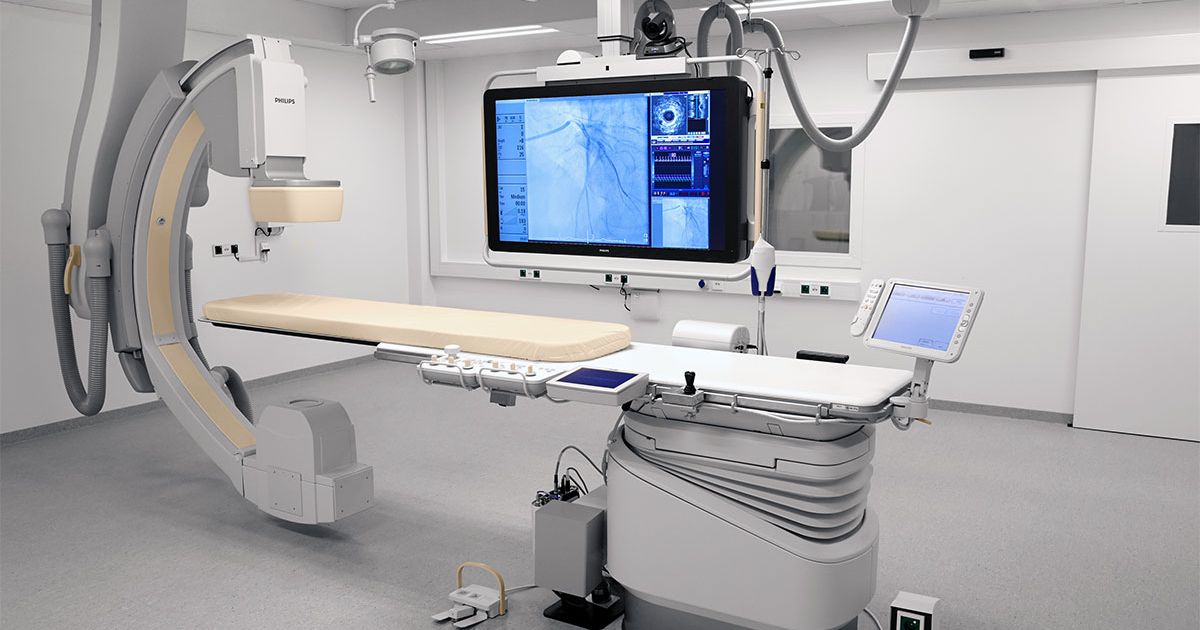We help healthcare facilities buy/sell imaging equipment, service and parts while lowering costs and improve quality for a better patient experience.
We help healthcare facilities buy/sell imaging equipment, service and parts while lowering costs and improve quality for a better patient experience.
Cardiac Catheterization Lab, or Cath Lab

Cardiac Catheterization Lab, or Cath Lab for short, is a specific laboratory with high-efficiency equipment for imaging of coronary and blood vessels in the body. Apart from displaying on the monitor, images will also be archived into a digital tape. They can be rotated and reviewed in 360° with great details and from any angle with agility and clarity. As a result, doctors can view the images from every perspective, offering a higher precision in diagnosing.
Cardiac Catheterization Laboratory Service
1. Catheterization for diagnosis and treatment of blood vessels in all areas using balloon and stent, angioplasty, and blood clot suction in clogged blood vessels.
The procedure can be applied to treat blood vessels in the following area:
- Coronary artery in a patient with angina pectoris and Ischaemic heart disease
- Carotid artery or vertebral artery in palsy or paralysis patients.
- Renal artery in patients with hypertension or chronic kidney disease due to renal artery stenosis.
- Blood vessels of the arm and leg with vascular diseases such as patients with pain when walking or diabetic ulcers.
2. Diagnosis and treatment of cardiac arrhythmia, including:
- Advance 3D mapping of the cardiac electrical system.
- Radiofrequency ablation
- Peacemaker insertion
- Implantable cardioverter defibrillator insertion
- Cardiac resynchronization therapy
When should Cath Lab Scan be Applied?
Cath Lab examination should be applied to coronary artery disease due to ischemic heart, causing the patient to have chest oppression or chest pain longer than 5 minutes, as well as easily become fatigued. However, Cath Lab will be applied as the final procedure for heart disease patients due to the risk of sudden cardiac death.
How is Cath Lab Scan Performed
The patient will be injected with local anesthesia, either at the groin or wrist area. Then, a small aseptic catheter will be inserted into the artery, until reaching the blood outlet. Afterward, a dye agent will be injected to monitor the cardiovascular functions, identifying any narrowing or clogging of the blood vessels. The doctor will be able to view these images on a digital monitor through a special x-ray box within approximately 20 minutes. If any abnormality is detected, a stent will be inserted for further diagnosis and treatment. Once completed, the catheter will be removed. A plaster bandage will be applied on the insertion area for a short while to cover the wound and stop the bleeding.
This procedure offers a fast recovery as it imposes lower risk and no major surgery is applied. Patients can return home and proceed with normal routine once the examination is completed.
Preparation for Cath Lab
- Patients must complete required physical checks such as blood tests, chest x-ray, electrocardiography, etc.
- Patients must be admitted 1 night before the procedure and sign the medical consent form.
- Patients should thoroughly shower. Once entering the treatment, the groin area, where the catheter is inserted, will be cleaned and shaved.
- No food and water for 6 hours before the examination.
- All clothes and accessories must be removed and kept with the related person or staff before the procedure.
Practice after Cath Lab Scan
- After injecting the dye agent, the doctor will advise the patient to lay still horizontally and adjust the bed until the patient´s head is positioned at 30 to 45 degrees. Then, the patient can gently walk or sit up. To avoid vascular tear, carrying of heavy objects or stern exercises are not allowed. The patient can lay down on the side, as well as moving their toes and fingertips.
- Staff will apply a sandbag over the wound in the groin area for at least 2- 4 hours to stop the bleeding.
- Inform the medical staff immediately if you have any heavy breathing, heart palpitation, pain, chest oppression, dizziness, excessive blood loss in the groin or wrist area, body and foot rashes, cold hands, numbness in toes and fingertips.
- Patients should avoid getting the wound wet. Once the wound is dry, patients can shower normally. If not, it should be wipe-cleaned with alcohol and dressed with plaster bandages.
- If water is allowed after the procedure, patients should drink plenty of water at least 2,000 cc per day. This way, the kidney releases the contrast media from the body through urination.
- Alcoholic beverages, tea, coffee of any kind, soft drinks, and smoking should be refrained from.
- Consume complete nutrition from 5 food groups. Refrain from food with high sugar, sodium, and oil to avoid overworking the heart.
Benefits of Cath Lab Scan
Cath Lab offers high precision and efficiency for cardiac catheterization procedures. Doctors can apply this to patients with the risk of cardiovascular diseases. It can also be applied to cases in which medications or other procedures were ineffective, to plan a more accurate treatment.